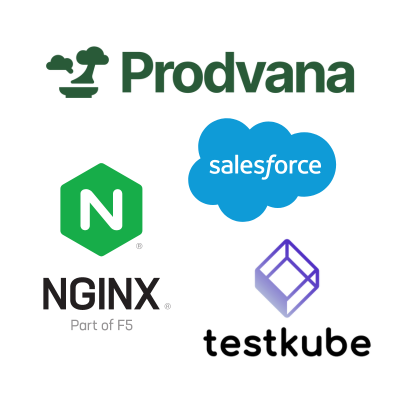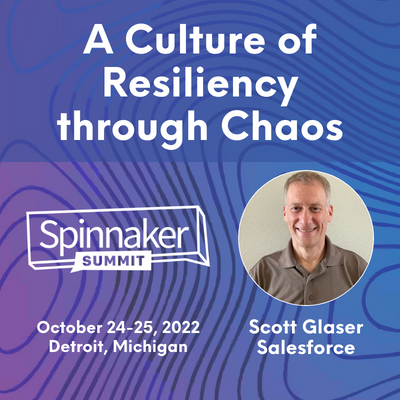





Originally posted on the Armory blog by Rosalind Benoit
I met Edgar Magana at Spinnaker Summit last year, when he spoke during Armory’s keynote as one of six Spinnaker champions. The energy and enthusiasm he brings to advocating for Spinnaker contrasts his intensity in approaching his role as operator of mega-scale cloud infrastructure. But, the more I get to know him, the more I understand that it’s one in the same. To enable Salesforce’s application owners to safely evolve software, he must ensure homogenous, predictable models for continuous delivery. Spinnaker has helped him make that a reality.
“Across multiple environments, we have to enable different models for Spinnaker based on security requirements,” he explains as he shares his standardization strategy.

“We templatize all the pipelines for consistency across services, with two types: EC2 instance deployments, and Kubernetes cluster pipelines. For Kubernetes, we require a lot of security hardening, and we need to use the same logging and monitoring mechanisms for all of our clusters.”
Every time Edgar’s team discovers a new configuration for Kubernetes, they upgrade that pipeline, which should trigger a service owner to relaunch the pipeline with new parameters, or sometimes, destroy their Kubernetes cluster and create a new one. “We make all these changes in development and staging first, of course,” he says, noting the dev, pre-prod, and prod Spinnaker instances his team maintains.
A security requirement that artifacts not be created in the same place that deploys services imposes an added complexity. It required Edgar’s team to innovate further, and split the baking process across two different Spinnaker instances. Luckily, they could configure this out of the box with Spinnaker by overriding parameters; Edgar appreciates that Spinnaker doesn’t hard-code a lot of configuration, as rigidity wouldn’t support Salesforce’s unique requirements. That has also allowed his team to create a “heavy layer of automation on top of Spinnaker,” providing guardrails for application owners.
Our conversation turns to the Spinnaker Ops SIG (Special Interest Group), which Edgar recently founded. A solid kickoff meeting produced several action items to be completed before the next scheduled meeting on February 27th at 10 AM, (always a good sign).
Most importantly at this stage, Edgar says:
“We want to reach out to more operators, people who are either struggling or evaluating Spinnaker. We need operators in different stages — super experts who control everything, like those at Netflix and Airbnb, operators that are getting there, like us at Salesforce, and those in the initial evaluation stage. The goal of the SIG is to have a place where operators can exchange use cases, and have a unified voice, just like other Spinnaker SIGs, and a path for specific features we want incorporated into Spinnaker. The community needed a place to discuss how to operate Spinnaker better. As an operator of large-scale infrastructure, I don’t want to share this system with only a few companies. We want to welcome new users and operators, and facilitate their transition from the POC (proof-of-concept) environment to the real thing. This will help us understand what kinds of features are more important.”
Does the Ops SIG also provide a place to vent and empathize? I sure hope so! “That’s the life of a cloud operations architect,” Edgar says when he has to reschedule our meeting, “we get called all the time, from account issues, to Spinnaker and Kubernetes configuration,” and lots more; indeed, once when I ping Edgar about this blog, he’s in a “war room” (boy, I sure don’t miss my Ops days right now!) But just like Armory, Edgar values empowering developers, and safely pushing control of applications and their infrastructure to the edge to fuel innovation. Better software is worth the hard work!
Another of Edgar’s goals for the Ops SIG: create reference architecture documentation for HA (high availability) and disaster recovery. “I want new users of Spinnaker to say, ‘I don’t need to reinvent the wheel; I’ll just follow these HA guidelines.” Architecture collateral will help Platforms and DevOps teams convince leadership that Spinnaker is a good investment for the company’s continuous delivery of software. This is where Edgar’s warm enthusiasm and operator’s intensity meet: empowering developers, empowering the community, empowering the planet.
I look forward to working more with Edgar and his team at Salesforce as part of the Ops SIG, our April Spinnaker Gardening Days online hackathon, and more. This is the kind of open-source heroism that will usher in the new industrial revolution!
Check out Edgar’s talk on Salesforce & Spinnaker from last winter’s Spinnaker Summit below, or hop over to the registration page for Armory’s upcoming, “I have Jenkins; why do I need Spinnaker?” webinar to reserve your spot!

712:23 PM – Nov 16, 2019Twitter Ads info and privacySee Edgar Magana’s other Tweets
Watch Edgar’s 8 minute talk, part of Isaac Mosquera’s keynote.:
Global CRM Leader Joins Community Committed to Growing Ecosystem of CD/CI Tools and Methodologies
San Francisco, Calif., July 1, 2019 – The Continuous Delivery Foundation (CDF), the vendor-neutral home for many of the fastest-growing projects for continuous delivery, today announced that Salesforce has joined the CDF as a premier member.
Salesforce joins other CDF premier members such as Cloudbees, IBM, Google, CapitalOne, CircleCI, jFrog, Huawei, and Netflix working together to make continuous delivery tools and processes as accessible and reliable as possible and grow the overall ecosystem.
Salesforce is increasingly adopting continuous delivery practices and tools to empower development teams to achieve a faster, more frequent release cycle. As a CDF member, Salesforce will help shape industry specifications around pipelines, workflows and other CI/CD areas, as well as provide foundational support for CI/CD tools.
“An ethos of community innovation is driving the next generation of enterprise software,” said Mark Interrante, SVP of Engineering, Salesforce. “Salesforce is proud to join the Continuous Delivery Foundation and empower developers everywhere to deliver apps at enterprise levels of trust, scale and performance.”
“With over 20 years of experience building software at scale, Salesforce has a lot of expertise to share with the community,” said Chris Kelly, Director of Open Source, Salesforce. “By collaborating with the CDF, we’re excited to help define the future of open source CI/CD tools, share our lessons learned as well as build on the industry’s experience.”
Open source technologies such as Jenkins, JenkinsX, Spinnaker and Tekton, which are hosted by the CDF, help development teams from companies of all sizes and industries improve their speed and productivity when creating cloud-native, legacy infrastructure, mobile, IoT, and bare metal applications.
“Salesforce is an established, global CRM leader, and we’re thrilled they’re working with us to help enterprises adopt CD delivery as quickly and easily as possible,” said Dan Lopez, CDF program manager. “With containers, microservices and Kubernetes on the rise, Salesforce and other CDF members have a key role to play in growing and sustaining the CI/CD ecosystem. With CDF members focused on this, software development teams are free to focus on delivering quick, stable code changes as easily as possible.”
Salesforce and other CDF members have hosting Continuous Delivery Summits this year, including events co-located with KubeCon + CloudNativeCon + Open Source Summit China and KubeCon + CloudNativeCon North America respectively. Details for the Continuous Delivery Summit in San Diego will be coming soon.
Salesforce is also a member of the Linux Foundation, the Cloud Native Computing Foundation, Hyperledger, the Internet Security Research Group/Let’s Encrypt, and the OpenAPI initiative.
Additional Resources
About the Continuous Delivery Foundation
Continuous delivery (CD) is a software engineering approach in which teams produce software in short cycles, ensuring that the software can be reliably released at any time. The Continuous Delivery Foundation (CDF) serves as the vendor-neutral home of many of the fastest-growing projects for continuous delivery, including Jenkins, Jenkins X, Tekton, and Spinnaker, as well as fosters collaboration between the industry’s top developers, end users and vendors to further continuous delivery best practices. The CDF is part of the Linux Foundation, a nonprofit organization. For more information about the CDF, please visit https://cd.foundation.
###
The Linux Foundation has registered trademarks and uses trademarks. For a list of trademarks of The Linux Foundation, please see our trademark usage page: https://www.linuxfoundation.org/trademark-usage. Linux is a registered trademark of Linus Torvalds.